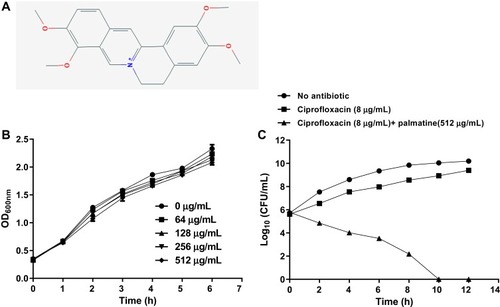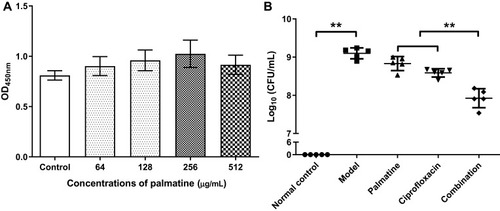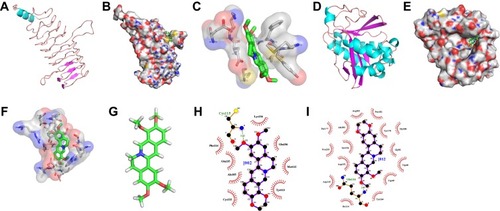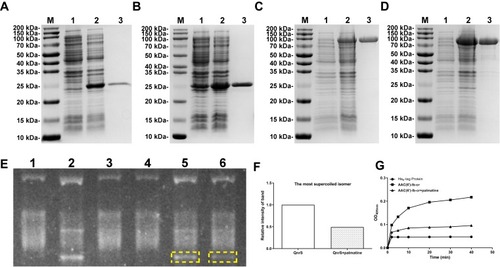Figures & data
Figure 1 Effect of palmatine on ciprofloxacin-resistant E. coli producing QnrS and AAC(6ʹ)-Ib-cr proteins in vitro. (A) Chemical structure of palmatine (B) Growth curves of E. coli 289 in the presence of the indicated concentrations of palmatine. Absorbance at 600 nm (OD600nm) was measured to determine the influence of palmatine on the growth of bacteria (C) Time-kill curves of compounds against E. coli strain 289. Values are the averages of three independent experiments.

Table 1 MIC and FICI Values of the Palmatine and Ciprofloxacin Combination Therapy for Each of the Tested Clinical Bacterial Isolates
Table 2 Effect of Palmatine on the Susceptibility of Recombinant E. coli to Ciprofloxacin Producing QnrS or AAC(6ʹ)-Ib-Cr
Figure 2 Effects of palmatine and ciprofloxacin combination therapy in vivo. (A) Palmatine cytotoxicity in murine RAW264.7 cells (B) Efficacy in mice intramuscularly infected with E. coli 289 followed by intragastric treatments of ciprofloxacin (10 mg/kg), palmatine (50 mg/kg), ciprofloxacin combined with palmatine (combination) or control solvent. Uninfected mice served as normal controls. The bacterial burden in the thighs was calculated by colony enumeration. **, p < 0.01.

Figure 3 Molecular dockings and specific interactions between palmatine and QnrS or AAC(6′)-Ib-cr. 3D structures of (A) QnrS, (D) AAC(6′)-Ib-cr and (G) palmatine (see text for details). Molecular surfaces of (B) QnrS and (E) AAC(6′)-Ib-cr after docking with palmatine (green structure) and detailed views of the interactions between (C) QnrS and (F) AAC(6′)-Ib-cr. Hydrogen bonds are colored cyan and the amino acid residues involved in the non-bonded contacts are represented by transparent surfaces. Interactions between palmatine and amino acid residues at binding sites of (H) QnrS and (I) AAC(6′)-Ib-cr. Residues contacting palmatine via hydrogen bonds are colored green and the numbers represent bond lengths. Residues that provide hydrophobic interactions with palmatine are colored in black with red eyelash symbols.

Figure 4 Interaction of palmatine with QnrS and AAC(6′)-Ib-cr. Purification of recombinant proteins visualized using SDS-PAGE for (A) QnrS, (B) AAC(6′)-Ib-cr, (C) GyrA and (D) GyrB. Lane M, protein molecular mass marker; Lane 1, total cellular extracts before induction; Lane 2, total cellular extracts after IPTG induction; Lane 3, extracts after Ni-NTA column elution (E) Palmatine reduces the gyrase protective effect of QnrS. 20 μL reaction mixtures were analyzed in 1% TBE gels. Reaction mixtures contained 0.25 μg relaxed pBR322 plasmid DNA (lanes 1 to 6), 2.8 nM gyrase (lanes 2 to 6), 6 μM ciprofloxacin (lanes 3 to 6), 2 μM purified His6-tag proteins (lane 4), 2 μM purified QnrS (lane 5) and 2 μM purified QnrS that were preincubated with 10 μM palmatine (lane 6). (F) Digital analysis of the most supercoiled isomer (yellow-dotted box). (G) Palmatine reduces acetylation of AAC(6′)-Ib-cr. 50 μM ciprofloxacin was incubated in the presence of 4 μM AAC(6ʹ)-Ib-cr protein or 4 μM AAC(6ʹ)-Ib-cr protein that was preincubated with 20 μM palmatine, an acetyl donor (acetyl-CoA) and an indicator (DTNB). Absorbance at 405 nm was measured as an index of acetylation (see text for details). 4 μM His6-tag proteins were used for controls.

